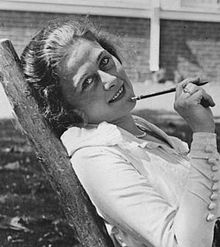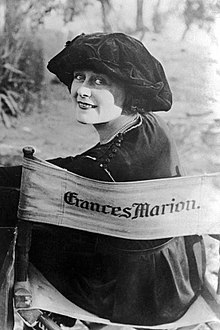Frances Marion
Frances Marion (born November 18, 1888 in San Francisco , California , † May 12, 1973 in Los Angeles , California; actually Marion Benson Owens ) was an American screenwriter and director .
Life
Frances Marion began her career as a journalist for the San Francisco Examiner and was one of the first female war correspondents during the First World War . In 1915 she began her career as a screenwriter in Hollywood , at that time one of the few domains in which men and women were equally active alongside the profession of film editor . In the 1920s she wrote a number of screenplays for FBO , where her husband, Fred Thomson , was the leading western actor. In the following years, she rose to become one of the highest paid authors in the industry.
She had her breakthrough through her long-term collaboration with Mary Pickford , with whom she worked closely on the scripts for successes such as The Little Pincess and Little Lord Fountleroy . In the mid-1920s, she moved to MGM , where she also helped direct some of Marion Davies' comedies in addition to writing the script. In 1927 she got her friend Marie Dressler , who was in financial difficulties, a contract with the studio and got her some good roles, including Anna Christie alongside Greta Garbo .
In 1930 and 1932, she won the Oscar for best adapted screenplay for her work on Hell Behind Bars (The Big House) and The Champ . The two films were instrumental in Wallace Beery's rise to become one of the stars of MGM. Beery was also a good friend of Frances Marion.
Her second husband was director George W. Hill , who directed some of her works, such as Hell Behind Bars and The Secret Six .
Over the course of her career, she wrote screenplays for more than 130 films and was one of the most outstanding screenwriters in film history. She retired from the film business in 1946 and wrote novels and plays.
Filmography (selection)
- 1917: Tillie Wakes Up
- 1917: The Little Princess
- 1917: The Poor Little Rich Girl
- 1917: Rebecca of Sunnybrook Farm
- 1918: Stella Maris
- 1919: Anne of Green Gables
- 1920: The Flapper
- 1921: The Little Lord (Little Lord Fauntleroy)
- 1922: The Toll of the Sea
- 1925: The Victim of Stella Dallas (Stella Dallas)
- 1925: Zander the Great
- 1926: The Son of the Sheik (The Son of the Sheik)
- 1926: The Scarlet Letter
- 1927: Anna Karenina (Love)
- 1928: The wind (The wind)
- 1928: Die Fahrt ins Feuer (The Awakening) (script)
- 1929: Their Own Desire
- 1930: Anna Christie
- 1930: Banditenlied (The Rogue Song)
- 1930: Hell Behind Bars (The Big House)
- 1930: The Strange Mother (Min and Bill)
- 1931: The Champ (The Champ)
- 1931: The Secret Six
- 1932: Emma, the Pearl (Emma) (script author)
- 1932: Blondie of the Follies
- 1933: Secrets
- 1933: The Prizefighter and the Lady (The Prizefighter and the Lady) (screenplay template)
- 1933: Dinner at Eight (Dinner at Eight)
- 1936: The Lady of the Camellias (Camille)
- 1937: Tatjana (Knight Without Armor)
- 1939: The Green Hell
Web links
- Frances Marion in the Internet Movie Database (English)
| personal data | |
|---|---|
| SURNAME | Marion, Frances |
| ALTERNATIVE NAMES | Owens, Marion Benson (real name) |
| BRIEF DESCRIPTION | American screenwriter |
| DATE OF BIRTH | November 18, 1888 |
| PLACE OF BIRTH | San Francisco , California, United States |
| DATE OF DEATH | May 12, 1973 |
| Place of death | Los Angeles , California, United States |

